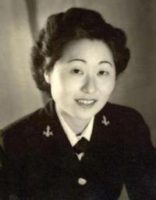 May is Asian American and Pacific Islander Heritage Month, so it seems appropriate to remember the life and accomplishments of Susan Ahn Cuddy, a Korean American who would serve as the first female Asian-American officer in the US Navy and would also become the first female Navy gunnery instructor.
May is Asian American and Pacific Islander Heritage Month, so it seems appropriate to remember the life and accomplishments of Susan Ahn Cuddy, a Korean American who would serve as the first female Asian-American officer in the US Navy and would also become the first female Navy gunnery instructor.
After leaving the Navy at the end of World War II, Cuddy also worked as an intelligence analyst and section chief at the National Security Agency and ran a think tank during the Cold War. She worked on top-secret projects for the Defense Department and supervised more than 300 scholars and experts in Russian affairs.
Susan Ahn was born in 1915 in Los Angeles, the eldest daughter of Dosan Ahn Changho and Helen Lee. Her parents were the first Korean married couple to immigrate to the United States.
Japan had annexed Korea in 1901. Her father was one of the leaders of the Korean independence movement. On his return to Korea in 1926, he was arrested by the Japanese and died while incarcerated in 1938.
After the Japanese attack on Pearl Harbor, Susan Ahn applied to join the Women’s Reserve of the U.S. Naval Reserve – better known as the WAVES, which stood for Women Accepted for Volunteer Emergency Service. At the time, the U.S. was putting more than 127,000 Japanese-Americans into internment camps. Cuddy learned later in life that her initial rejection by the Navy was because of her race.
She applied for the second time, and in December 1942, she was accepted as an enlisted member. In 1943, she became an instructor teaching aviators how to maneuver in an early cockpit simulator and later become a gunnery instructor.
An officer who recognized her abilities recommended her for officer training. After completing the 90-day officer training course, she was commissioned as a WAVES officer.
With experience as an aerial gunnery instructor, the Navy used her as a test case. In November 1943, she was sent to gunnery school in Pensacola, Florida, to train on a variety of weapons. Upon graduation, she became the first female Navy gunnery officer. In January 1944, now-officer Susan Ahn was sent to Atlantic City Naval Air Station to train naval aviators on how to fire a .50-caliber machine gun.
By the time she became a lieutenant, Susan Ahn had begun working with elite codebreakers at the Naval Intelligence Office, thanks to her ability to speak Korean. But people there were still suspicious of her because of her race. She said during an interview that one of her supervisors initially wouldn’t let her near classified documents. Eventually, however, she proved her worth and the office chose her to be its liaison with the Library of Congress.
After the war ended, Susan Ahn joined what would become the National Security Agency (NSA). In her waning days with Navy intelligence, she met Chief Petty Officer Francis Cuddy, an Irish American code-breaker who also worked on matters pertaining to Korea’s independence. The two fell in love and married in April 1947. The pair lived in Virginia, but its laws at the time didn’t allow for interracial marriages, so they held the wedding in Washington, D.C. Neither family approved of the union at first.
The couple moved to Los Angeles in 1959 and had two children; a daughter, Christine, and a son named Phillip. In addition to managing a family restaurant, Susan Ahn Cuddy continued to support the city’s growing Korean American community and worked to preserve the history of her pioneering parents and other Korean immigrants.
She died in her sleep on June 24, 2015, at 100 years old.
Susan Ahn Cuddy, first female Asian American Officer, Gunnery Officer In United States Navy
